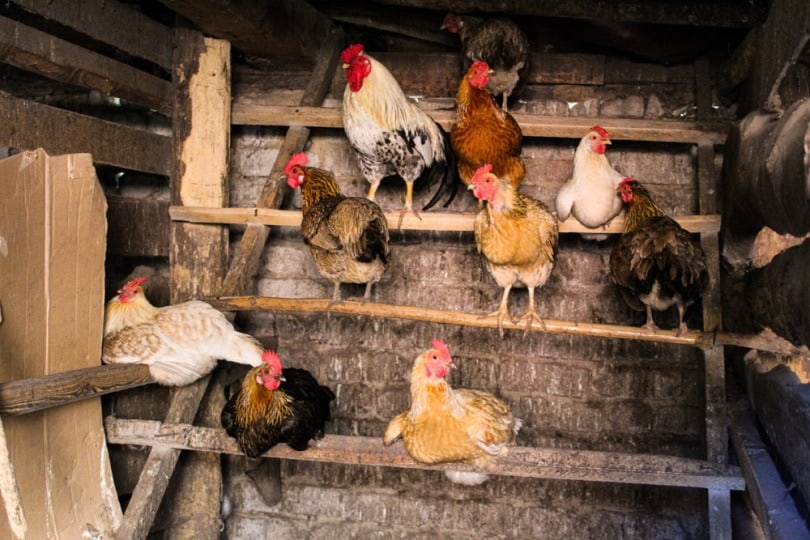If you have chickens, they’re going to need roosts! A roost is an elevated bar, branch, or plank that chickens perch on at night to sleep. Chickens instinctually seek out higher places to sleep to give them an advantage over predators. You may have noticed your own birds trying to find the highest places that they can settle onto for the night. Roosting bars in a chicken coop are always recommended to keep the flock safe and comfortable. Even if there is no way that any predators can get to the chickens, this behavior is deeply instilled in them and they will continue to roost. Fortunately, roosting bars don’t have to be expensive purchases or complicated endeavors. Even if you have no previous building experience, here are 11 of the best chicken roosting bar plans that you can make yourself.

The 8 DIY Chicken Roosting Bar Plans
1. Tree Branch Roosting Bar

A dead tree or tree branch can be trimmed to length and hung from the coop’s ceiling. This makes a large, comfortable, and free roosting bar. Since the diameter of the branch is so large, the chickens can spread out their feet and lower their feathers over them as they settle in for the night. This helps keep their feet warm in cold weather. Be sure to sand any rough edges and inspect the branch for sharp pieces that could cause any injuries to the birds.
2. Repurposed Playset Roosting Bar
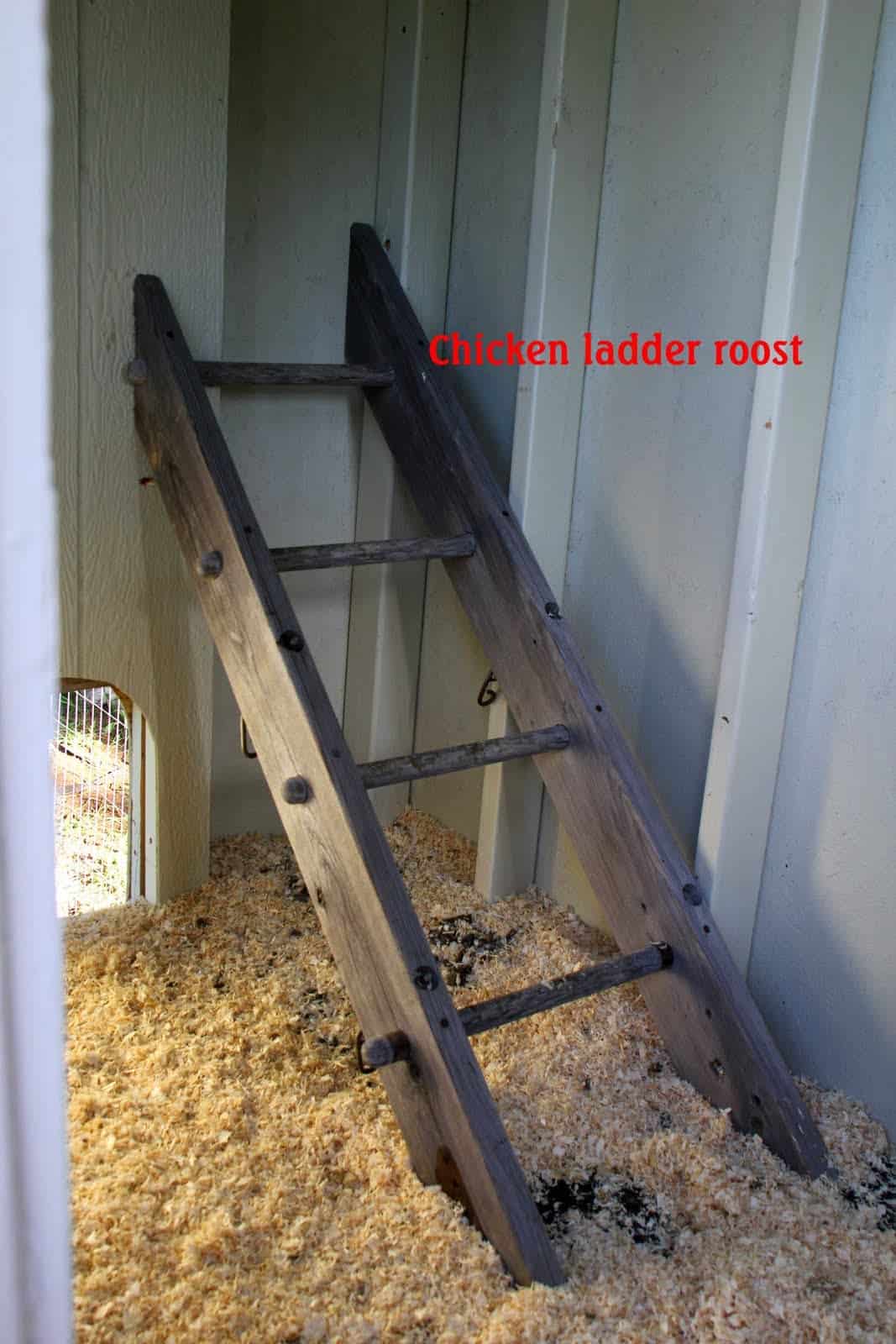
Do you have an old swing set that the kids don’t use anymore? Remove the monkey bars from it, and attach them to your chicken coop’s wall. This keeps chickens high off the ground and enables them to still remain close together for safety and warmth. Several chickens can fit across one bar, so this handy recycled item gives you multiple roosting bars at once.
3. Gutter Roosting Bar

Rows of tree branches above an angled ramp enable chickens to roost while the attached gutter at the bottom collects any overnight droppings. Multiple chickens can use this at once. The roost bars can be as long as you need them to be to fit your space. Cleaning out the gutter is simple and keeps your floors clean.
4. Tiered Chicken Roost

Chickens love to climb, and this tiered chicken roost gives them that opportunity. A wooden post can be secured in the ground with dirt or poured concrete for a sturdier feel. Log pieces can then be fastened to the post with L-brackets. These platforms give chickens a bit more room to lounge than a regular roosting bar does. Since chickens can also eat on these platforms, they should be cleaned and sanitized after use.
5. Wood Slats Chicken Roost
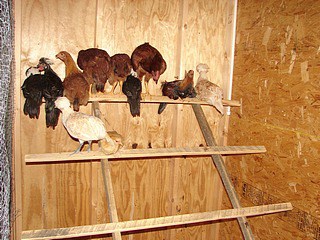
A simple solution for your chickens to have a place to sleep is crafting a roost out of wooden slats. Simply screw the slats together, and attach them to the wall on a slope. The chickens will have room to sleep with adequate space for waste removal. The slope also enables the chickens on the lower levels to not be directly underneath any others.
6. Ladder Roosting Bar
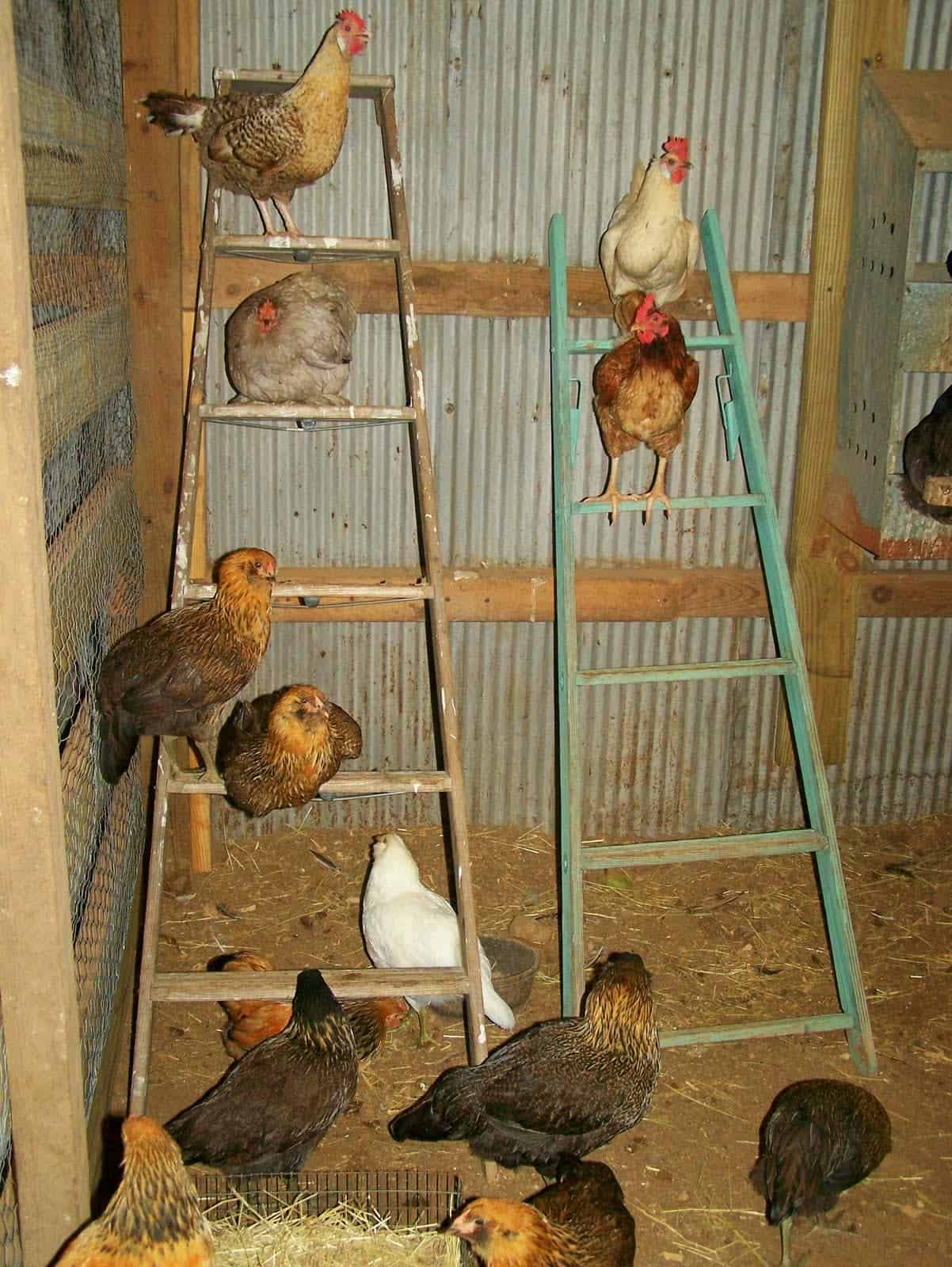
Requiring almost no work at all, an old ladder is an extremely easy way to give your chickens the roosting bars that they need. It’s best to attach the top of the ladder to the wall to keep it sturdy, especially if you have a large number of chickens. They can climb, sleep, perch, and rest on the ladder rungs. Secure the ladder on an angle against the wall so the chickens have room to maneuver in the space.
7. Triangle Roosting Bar
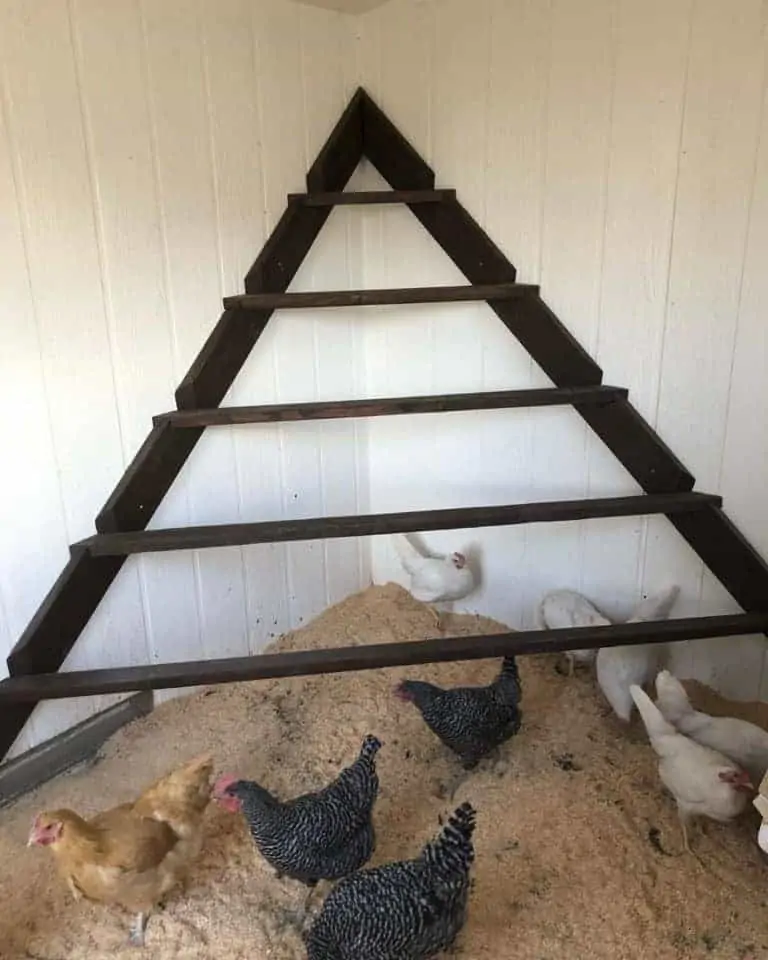
By using wooden slats to build a triangular-shaped roosting bar, you can utilize the corner of your chicken coop and give your chickens a comfortable place to sleep. If your coop is small, this is a unique way to maximize your space. The A-frame roost is also an attractive feature to add to any coop.
8. Rustic Chicken Roost

This chicken roost adds a rustic feel to a coop and can be made simply by suspending tree branches or small logs from the ceiling. Cut the wood to create the size of the swing that you’d like to have, and fasten the pieces together to make a platform. Be sure to sand any rough edges. This swing should be low enough that the chickens can reach it but high enough to keep them off of the floor. Chickens can enjoy the added swinging feature.

Why Do Chickens Roost?
Chickens aren’t that fast and tend to sleep soundly, so roosting is part of their survival instincts. They find the highest perch that they can at night to keep them off the ground and out of reach of predators like foxes and coyotes. If roosting bars aren’t available, chickens may resort to sleeping in nesting boxes or on the floor of the coop. These options are unsanitary for them. If they soil their nesting boxes, they may also refuse to lay eggs in them.
Chickens are prone to parasites and bacteria if they are left to sleep in their own waste. Clean sleeping areas are required in order to have happy, healthy birds.
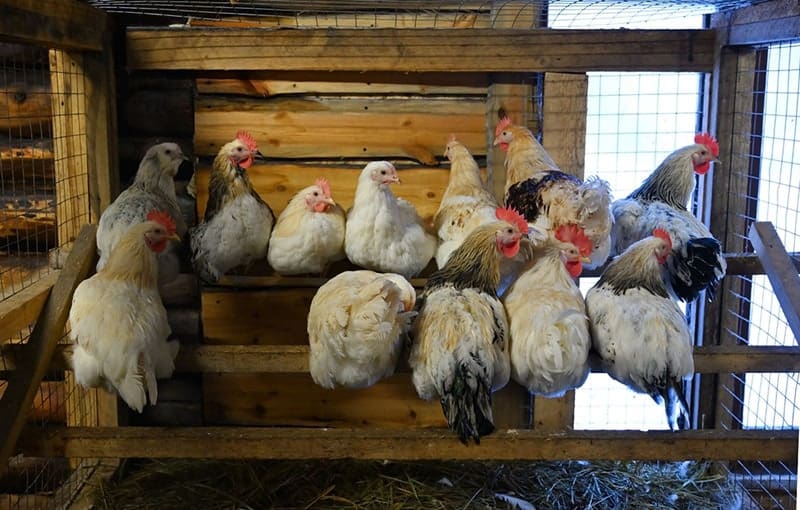
Roosting Bar Location
Outside of the coop, roosting bars can give chickens a place to relax during the day. When they’re outdoors, they enjoy climbing and swinging. These activities help keep them from being bored, give them exercise, and let them safely observe their surroundings.
Inside the coop, the roost should be placed where the chickens will sleep. The spot that you choose for this should be clean and convenient. Avoid ventilated spots where the chickens will be forced to sleep in drafty, cold areas. Food and water sources should be placed away from the roosting bars so the chickens don’t have a chance to soil them from above.
Roosting Bar Materials
The best material to use for your roosting bars is wood. It’s durable and easy to cut and shape to fit your specifications, and it’s usually easy to acquire. You can purchase the wood or use tree branches and logs to build your roosts. If you do purchase wood, it should be untreated and free of chemicals.
Metal is not suitable for chicken roosting bars because it gets extremely cold in the winter and hot in the summer. It’s also slippery and smooth, making it difficult for chickens to perch on comfortably and hang onto. To avoid damaging your chickens’ feet and causing discomfort, avoid metal in your roosting bars.
Plastic is not suitable for roosting bars either due to its ability to warp if it’s hot and shatter if it’s cold. Chickens are in danger of injuries by walking on or accidentally eating broken plastic shards. Like metal, plastic is also too smooth for chickens to perch on comfortably.
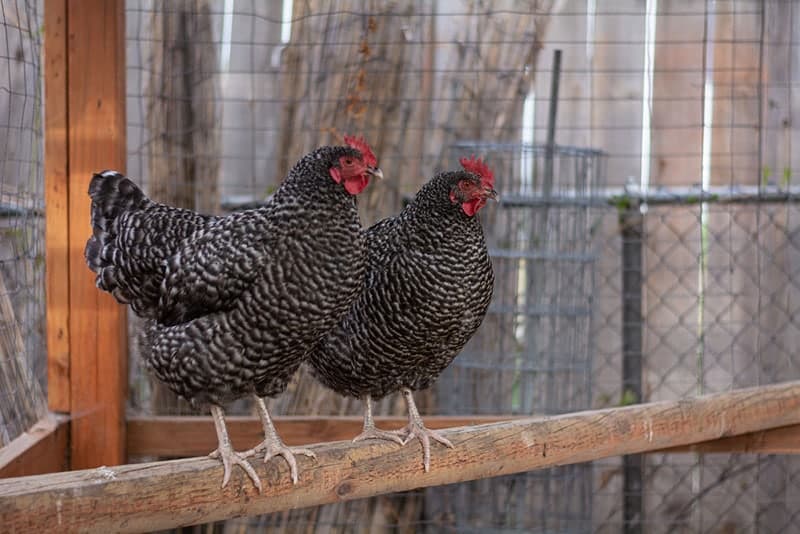
Chicken Roosting Bar Height
You want your roosting bar to be off the floor, but not so high that your chickens have difficulty reaching it. The ideal height is 18 inches off the ground. This way, chickens can jump or fly up to it. If it’s any higher, your chickens may need a ramp or stairs to help them climb up and reach it.
Bars placed at various heights will give chickens the option to choose where they want to perch. Heavier chickens like to be on lower levels.
Also, chickens adhere to a pecking order, where the highest-ranking members perch at the top. Lower members in the order perch on the bottom or at the ends of the bars, sometimes keeping an eye out for predators overnight. Bars set at different heights will let them follow their order.
Roosting Bar Size
The roosting bars should be large enough for chickens to steadily perch on without wobbling. A good rule of thumb is 2” x 4” of perch space so they can comfortably sit down and cover their feet with their feathers. Anything thinner may make it uncomfortable for your chickens and they may not be able to sleep.
The length of the bars should accommodate the number of chickens that you have, but when in doubt, go with more space than less. Each chicken needs at least 8 inches of roosting space, but they tend to huddle closer together in the winter months. This space gives them that option, along with enough room for each bird to spread their wings and stretch out comfortably.

Splinters and Rough Spots
When your roosting bars are complete, be sure to check them over for any splinters or rough areas that can damage your chickens’ feet. Bumblefoot is a common infection that can be brought on by uneven or splintered surfaces. While the infection starts from a wound on the foot’s surface, it can quickly spread to muscles and bone, even causing death. Keeping their roosting bars smooth and even can reduce the risk of this condition.
Why Aren’t My Chickens Using the Roosting Bars?
There are a few reasons that chickens will refuse to use roosting bars. If you notice this happening, check for the following problems.
- The bars aren’t stable enough. If the bars are too weak, they can get overloaded and start to sag or snap in half. If chickens feel unstable, they will find another spot to sleep that may not be convenient.
- The bars are too rough. If they aren’t sanded and smooth, they can be painful for your chickens to perch on.
- The chickens can’t easily access the bars. Are there obstacles in the way of your chickens being able to jump or fly onto the roost? Are the bars too high for them to reach without a ramp or stairs?
- They don’t know what the bars are. While it’s an instinct for most chickens to perch up high to sleep, some younger birds may not know that the bars are there or what they’re for. You may need to repeatedly place the birds on the bars to show them what to do.
- The bars are too crowded. If there isn’t enough space on the bars for every chicken, the remaining chickens will be forced to sleep on the ground.
- The bars are dirty. Bars should be cleaned and sanitized regularly to remove waste, bacteria, and mites.

Final Thoughts
Chicken roosting bars are necessary for your flock to keep them happy, healthy, and well-rested. With these easy DIY ideas, you can be as creative as you want with your design. Many of the materials that you need are easy to acquire. Using a few tools, you can create a unique roost for your chickens at little to no cost. With planning and care, your chickens can have comfortable, safe places to sleep.
See also: 15 DIY Chicken Toys to Entertain Your Flock
Featured Image Credit: Bondareva Elena, Shutterstock
